-
Saving the movie
Last week we enjoyed the Mario Bros movie in theaters with the kids. It’s a delightful movie with a simple plot, heroic moments, brave moments, a bad guy that isn’t evil incarnate (how novel!) and no parents die in the first 15 minutes of the film. 8/10 would see it again
It features yet another character voiced by Chris Pratt. He’s everywhere these days! I wanted to learn more about this constant presence so I looked up an interview with him from last year on the Smartless podcast. Mid-interview he mentions he is looking forward to going fishing with his 9yr old son for a week at his ranch in Montana, just the two of them. His plan is that they will fish, and they will watch a movie together every night.
Here’s the list he had planned for them to enjoy together:
Rambo: First Blood
Dumb and Dumber
White Fang
PeeWee’s Big Adventure
Rudy
Toy Soldiers
Red Dawn
Bloodsport
Monty Python and the Holy Grail
So these movies are mostly more mature than what I would line up for a 9yr old. But regardless I loved the planning. I can relate to the urge to show them early too, because there is always that fear that your child will watch without you a special movie that you hoped to share with them—whether at a sleepover, on an airplane, or on a device while passing time on a road trip. I’ve learned from experience that you do need throw a soft lasso around the movies you’re hoping to share, so they can be savored together and not slip into the memory murk of “oh I saw that one already,” before you have the chance.
Chris Pratt’s list and plan reminded me of a recent special memory-movie moment I had with the girls. After a New Year’s week in Florida, I was driving the girls up to Orlando to meet up with their grandparents so they could go to Harry Potter World together. Because of a mixup in scheduling, I had an extra two nights before I needed to get them there. Hunting for something special to do together with these free days, I stumbled onto the existence of Legoland just south of Orlando. School vacation week was wrapping up, so there was last minute availability in the Lego-themed hotel. After debating for a few hours if it would work with one adult and four kids, I bought a package of two days at the park with a two nights stay. The Legoland hotel room fits five people, a very unique trait in hotel rooms. The way they manage this is by having a built in bunk bed with a third trundle below that. They do other family-friendly things like putting tiny Lego kits in the room after housekeeping, offering free family-style breakfast downstairs and maintaining the warmest pool temperature I have ever experienced. After a fun first day at the park, walking over five miles together (we rented a stroller at the entrance for the 3yr old), trying as many rides as we could, we collapsed back at the hotel room. I found a place to deliver pizza and realized the hotel TV had all the Lego movies cued up to watch. We decided to try The Lego Movie. If you’ve seen it, you know what we saw: a hilarious and fun not scary movie that makes you think about life as it is as well as reminds you how much you love Lego. We paused it halfway through to share the pizza on the hotel room floor, not wanting to get in on the bedspread, then curled up together on the queen sized bed to finish it together. Every time I see The Lego Movie for the rest of my life, I’ll remember this experience.
What’s a movie you’ve saved to experience with someone?
-
a rocks and minerals party

We were making a pavlova—that wonderfully messy dessert that looks like a dried cloud on your baking pan, fingertip crunchy on the outside, soft and marshmallowy on the inside. The pavlova was for friends who were coming for dinner that night, but as we made it—whipped the eggs whites in the thundering mixer for minutes on end—thoughts turned to cake in general, and then desserts on the whole, and we began to discuss the type of birthday party for which a pavlova would be the perfect cake. It looks likes a cloud…a rock…a mineral. And there we had it, our theme for the collective birthday party for the two older girls that summer.
The rocks and minerals theme went exactly as far as thus:
+ jello made with chilled hibiscus tea that shimmered with gemmy iridescence. We pompled this with rock candy bits that looked amazing; and promptly melted into puddles once outdoors. The kids didn’t notice but I wouldn’t recommended the additional step of pompling to you. I would recommend the tea jello—I added some sugar to the chilled tea, the kids loved the color and I could use what I had in my pantry tea cupboard.
+ favor bags: one golden rock candy swizzle stick, one geode for cracking open at home, and a little bag of purple rock candies.
+ a table strewn with our collection of rocks, and a rocks and minerals handbook, plus crayons and paper for those less inclined to fling themselves into ruckus group games, one of which seemed to be cheerfully shouting hello? hello! at each other for ten minutes.


The rest was very simple–play as you wish, run around outside, let the moms gather on a picnic blanket to chat in that sleepy afternoon way that they do, let the babies trip in the grass, let the older brothers look bored, munch on handfuls of white cheddar popcorn, spill pink lemonade, sing, sing twice because the three-year-old was on the couch with a fever and felt terribly left out.
Eat pavlova colored with sedimentary lines of food coloring and sharp pink raspberry sorbet, open presents. Go home.
Do you open presents at your birthday parties? When we were in Boston it had largely fallen out of favor. The gifts were typically huddled in the corner to be opened after the party, almost as if we were collectively embarrassed by their grandness. But I remember loving that part of parties as a kid. I loved seeing the different things my friends would receive. It was like wandering the aisles of the most personalized shop I could imagine. And I couldn’t wait till they opened my present and I could bask in the joy of believing I had given the perfect gift.
So, we do it now. The kids gathered into such a tight cluster, I could barely see what was happening, but I could see the smiles of pride on the giver’s faces as theirs was unveiled because they would look up and around for a moment, as if to catch the spotlight they were sure was searching for them.

My favorite pavlova recipe, from Repertoire by Jessica Battilana. Making a pavlova makes one feel like a magician master of substance and sugar.
For the meringue:
1 cup granulated sugar
1 tablespoon cornstarch
3 large eggs, separated
Pinch kosher salt
1 teaspoon lemon juice or white vinegar
1 teaspoon vanilla extractTo make the meringue: Preheat the oven to 250 degrees and line a rimmed baking sheet with a silicone baking liner or parchment. In a medium bowl, whisk together the sugar and cornstarch. Put the egg whites and salt in the bowl of an electric mixer fitted with the whisk attachment (or in a large bowl with a handheld mixer). Mix on medium speed until the whites hold soft peaks, then add 3 tablespoons of cold water and continue beating until the whites again hold soft peaks. Increase the speed to medium-high and add the sugar and cornstarch mixture 1 tablespoon at a time. When all the sugar has been added, beat 1 minute more.
Add the lemon juice and vanilla, increase the speed to high, and continue to beat the egg whites until they hold stiff, glossy peaks, 5 minutes more. Transfer the meringue to the prepared baking sheet and, using an offset spatula or the back of a spoon, gently spread into a circle about 8 inches wide, slightly higher on the sides and with a slight depression in the center.
Bake the meringue until pale golden, about 45 minutes. The meringue will have a crust on the exterior but still be soft inside. Turn the oven off, crack the oven door slightly (stick a wooden spoon in the oven door to keep it propped open) and let the meringue sit in the oven for 1 hour. Remove from the oven and let cool completely. Once cool, run a spatula under the meringue to free it from the silicon baking mat or parchment and transfer to a large plate. The meringue is best made the same day you plan to eat it. If you prefer, you can make individual meringues; prepare two baking sheets, then spoon four equal-size mounds of meringue onto each of the baking sheets, for a total of 8 meringues. The baking time is the same.
I added a tiny bit of food coloring (the gel kind) to the mixer at the end, then swirled in more food coloring with a toothpick once the meringue was on the pan, just before baking. The cake pictured above was the recipe made three times. I portioned all the ingredients ahead of time and mixed and baked the layers one after another. It fed twelve kids and six adults.
-
ann patchett’s book club
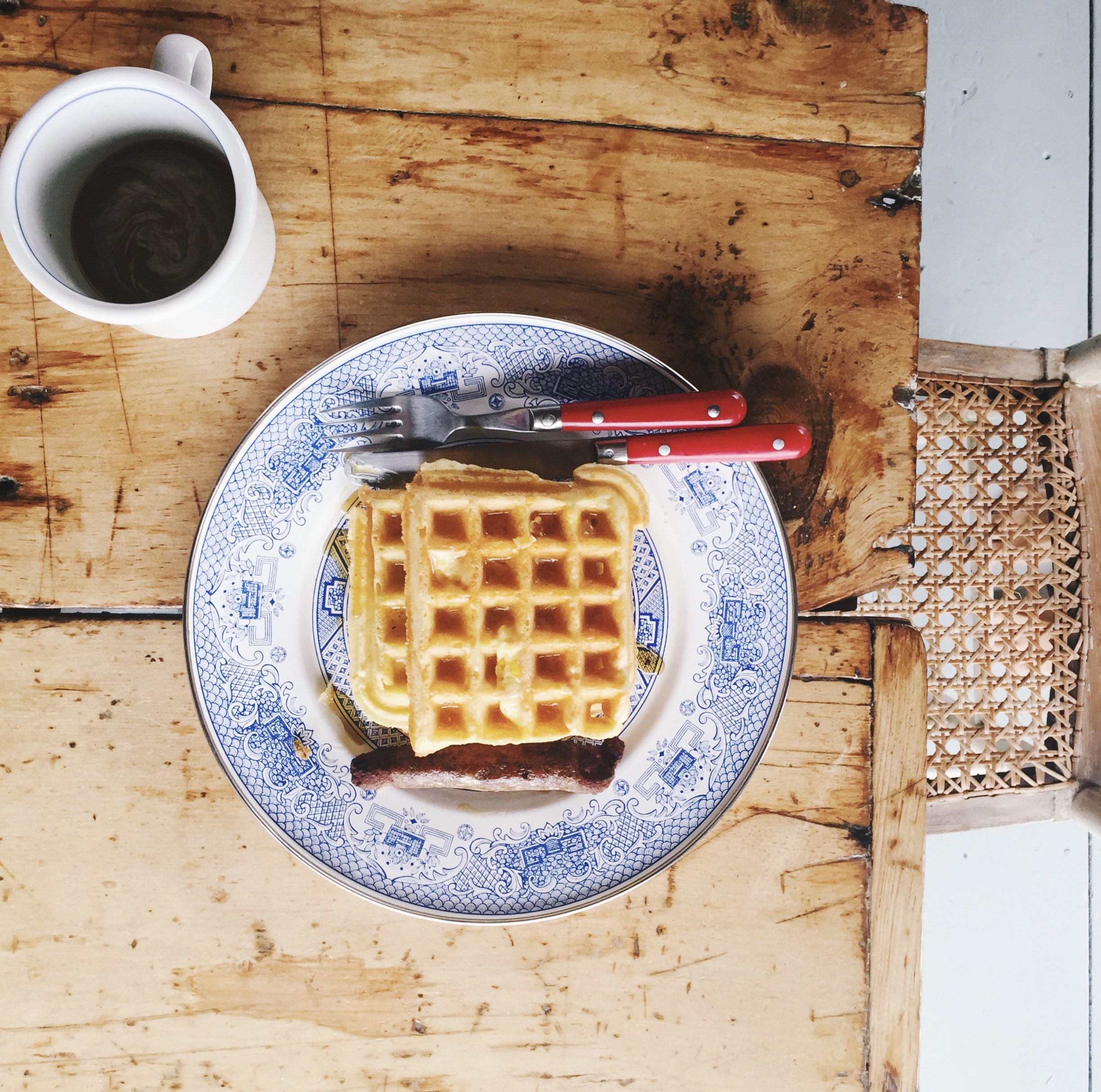
Eight months in, I’m so glad I joined Ann Patchett’s book club. The Signed First Edition Club ships a book to you each month, signed by the author. It arrives in a small cotton bag with a note from the book buyer about why she loved it. Sometimes it has a note from Ann instead, like April’s amazing galactic-friendship fiction, Lost and Wanted by Nell Freudenberger.
I once read a remark along the lines of: If you want people to buy your book, you better be buying their book. As in, if you believe in books, buy books.
And after thinking about it for a while I decided I could commit to buying a new book each month. It is a bigger commitment than one would think. Somewhere in the frame of $30 a month puts it just under our daily coffee bill (we also prefer to get beans by mail subscription. Ah, the country life.).
It’s run out of the bookstore Ann owns in Nashville. Each month the new book shows up in my post office box. Our town gives us this post office box for free because the Postal Service doesn’t come up our road. Initially, I resented this NEGLECT on the Post’s part, but soon I realized it was an enormous advantage, to not have to see your mail every day. Or only seeing it when you wanted to: as an occasion. It doesn’t make the bills less bill-y but at least it makes a stack of them to be looked through with some formality and attention. Ah the mail, I say to myself looking through them with magnanimous cheer. The magazines pile up too. And the notes. All in all, the haul is often satisfying.
Or it could be just the click of the tiny door, the dark key that the girls take turns using, and the chatting of pleasantries with the postmistress that feels nice.
Ann has a funny story on the store’s blog about getting the book club going. She used her power as a famous author-interviewer to get Tom Hanks to sign his books for the First Edition Club’s subscribers. She asked for signed J.K. Rowling copies for her members in lieu of getting paid an interview honorarium. I was very impressed by these stories. I can imagine Tom gently sighing as he signed the 600 copies she requested. Circle of publishing celebrity life, he perhaps muttered.
A few other perks: the idea of reading the book very first thing, a book you will likely end up reading eventually so you can participate with the reviews and accolades that pop up later. Maybe you’ll even notice in advance when the author comes to your town on their book tour. And you have supreme gracious lending rights: you can let a friend borrow it and almost guarantee they haven’t read the book yet.
Parnassus Signed First Edition Club
-
a no-drama guide to bullet journaling
When I realized my friend Kate was three years into her bullet journaling habit, I couldn’t resist asking her to elucidate her method and approach for us. There’s something truly remarkable about mixing the daily practical schedules of a mother, a devoted school librarian, and an ambitious household manager alongside the grander schemes of a young woman’s mind and the interests of an omnivorous pop culturist. I loved getting this peek into the inner workings and I hope you do too.
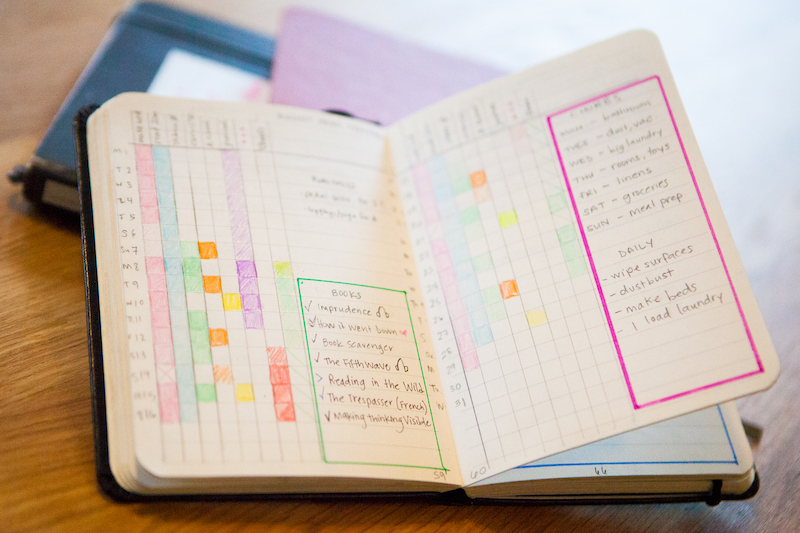 by Kate Bowman-Johnson. Photos of Kate’s journals by Leah Hood.
by Kate Bowman-Johnson. Photos of Kate’s journals by Leah Hood. Recently, in the middle of an intense counseling session, I found myself breaking out my planner: Exhibit A.
“This is what it’s like inside my head all the time,” I told my therapist. “There’s no rhyme or reason, half of it’s indecipherable, there are pages of incomplete tasks, and there is a lot of space devoted to bad television.”
She flipped through the journal slowly. “Okay,” she said, “but I also see illustrations by your kids. There’s some beautiful art in here. I see a lot of tasks crossed off. I see smart workarounds, sermon notes, and a list of what’s making you sad. It seems like this journal helps you manage your mental health in a productive way. I don’t look at it and see someone who’s failing.”
Well. A more on-the-nose introduction to this piece I could not have dreamed up. Fellow havers of mom-brain and assorted mood disorders: welcome to Bullet Journaling as Therapy. Less a fun tutorial, more a reflection on how a book and pencil saved my sanity – and just might save yours.
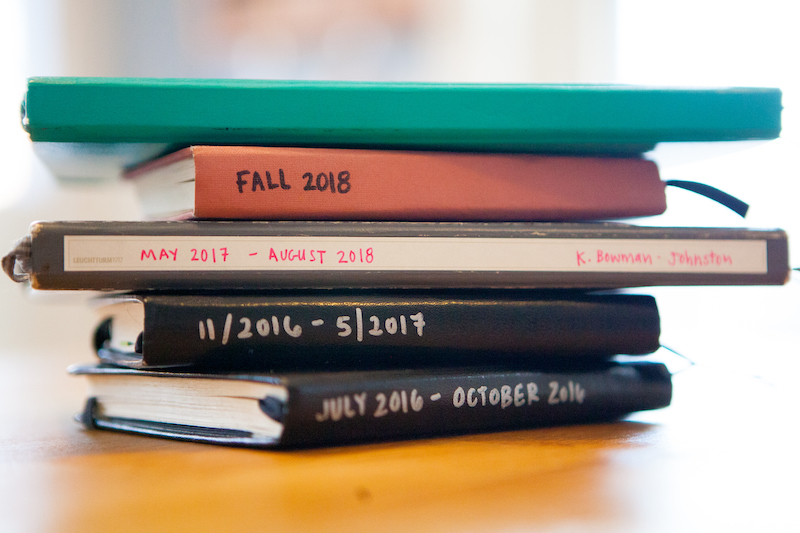
I started bullet journaling three years ago during a particularly busy season in my life. I had two young kids, I was a year into an exciting but whirlwind job, and I was actively fighting depression and anxiety. I kept forgetting important dates and dropping the ball. Post-it notes were stuck to every surface. I had three different Google Calendars, none of them synced. Sometimes I would write things in a Moleskine, then lose the Moleskine. It was bad.
I don’t remember exactly how, but I stumbled on a video about bullet journaling from the method’s creator. It immediately hooked me because of its simplicity, adaptability, and clear organization. I liked the balance between freedom and structure, two poles between which I’m constantly pulled. It seemed just the thing for someone like me, who’s equal parts fastidious and forgetful, creative and downright lazy.
So I grabbed a small notebook I already had on hand, watched some more videos, read some more tutorials, and set up my first bullet journal with only a Ticonderoga pencil in hand. (As an educator, I’m here to tell you that no other pencils need apply. Some things are worth the brand name.)
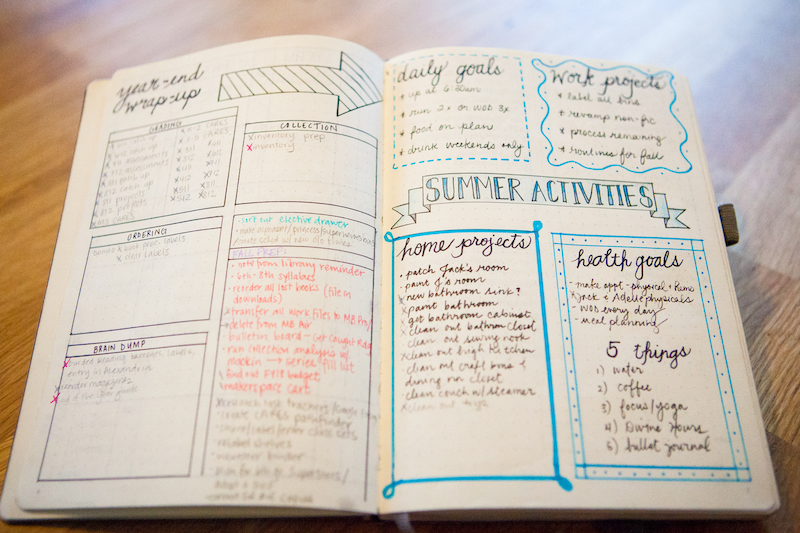
Three years in, bullet journaling is one of the few things in the universe that has not only lived up to the hype, but proved sustainable for me. It’s transformed my busy life and busy brain. It’s a way to self-soothe when I feel like things are falling apart around me; if I can capture them in the moment on paper, they’re not so daunting. They’re contained, yet accessible at all times. Mischief managed.
Since I began in 2016, much has been published about bullet journals and their Pinterest-ready cousins, dot journals. There are endless articles about how to set up your journal and embellish your journal and invest your fortune in stencils and washi tape. Such tutorials have been very useful to me (this one by Rachel Wilkerson Miller is the gold standard, if you want to familiarize yourself with the basic tenets, and I also like her book Dot Journaling: A Practical Guide), but the market is saturated. Instead, I hope to share a few guiding principles for people who are looking for more than just, as Rachael so aptly put it, a “relentless to-do list” – but may feel overwhelmed by getting started.
Flexibility is a feature, not a bug. Since you create a bullet journal by hand in a blank book, one page at a time, you can do literally whatever you want. Which is terrifying for someone like me. There is nothing I like more than following rules (Enneagram 6!), so I’ve had to push myself to bend and break them – but mercifully, journaling is built for that. For example, I used a weekly spread for months before I realized it was stressing me out and got rid of it. The world did not end; my process just got more efficient. Similarly, you’re not “supposed” to set up dailies ahead of time – but making a new spread once a week isn’t realistic for me. I make them all at the beginning of each month and I don’t feel bad about it, because it works. Meanwhile, all of my sections are interspersed with the weird art my kids make while waiting at the doctor, random lists, recipes, project-planning spreads, etc. There’s no BuJo police and they are not coming for you. Do you.
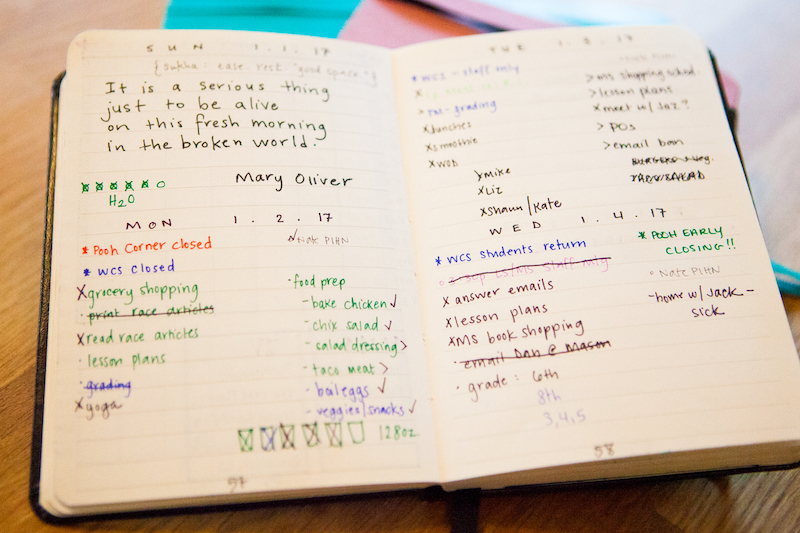
Keep the ‘gram at arm’s length. The internet is full of talented folks with gorgeous BuJo spreads and a lot of time on their hands. Their work is informative and inspiring, but take it with a grain of salt. Your bullet journal does not need reams of watercolor landscapes or brush lettering to work for you. Minimalist journaling is its own subculture, worth investigating if you get turned off by the fancy stuff. Personally, I check in on a few noted journalers once in a while if I’m feeling stagnant or need specific layout ideas. But by and large, I try to view those accounts as pure eye candy – not an indictment of how much I suck at planning and/or art. My own journals run the gamut from painstaking brush-lettering to hastily dashed grocery lists; it all depends on how much time and energy I have on hand.
Let accessories take a backseat. I know it’s tempting, because there’s so much cute stuff out there, and it’s so cheap on Amazon. As someone guilty of buying up hobby gear only to abandon it two weeks in, I forced myself to try bullet journaling for a whole month with only the resources I had on hand (journal, pencil). Then, once I had a better idea of how I was using it, I invested in a few simple tools: a small metal ruler, reusable page markers, and erasable pens. Years later, I’m the proud owner of some Tombow brush pens and layout stencils, but I usually default to a simple approach because it keeps the focus on the content.
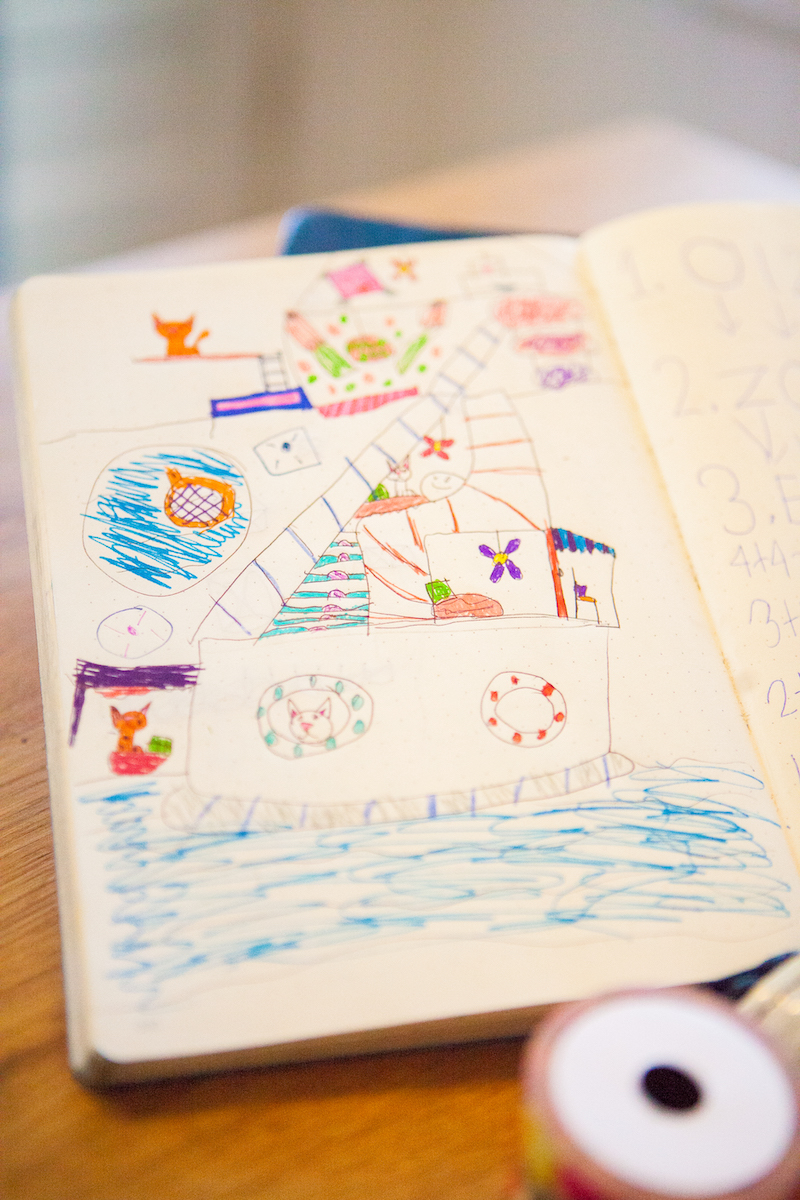
Find a balance with digital tools. When I upgraded my phone, it had an unexpected effect on my journal. I found myself abandoning the habit trackers that make dot journals so pretty, but they had become superfluous now that I had apps. Clue hacks my cycle; YNAB tracks expenses; Noom covers nutrition and exercise – so those stay in the cloud. On the flip side, I still put TV shows I’m watching in my journal (I’ll explain why in a minute), and I also meal plan on paper. The only things I duplicate are calendar appointments – hand writing them sears them into my memory, but I also need those automated pings and dings from my phone – and my reading list, which I keep on in my journal as well as plug into GoodReads. Otherwise, the division of labor is pretty clear. Don’t make your journal work harder than it needs to just for the sake of looking impressive!
Write it all down. One of my favorite BuJo functions is that of a lazy diary. When we’re on vacation, I summarize each day’s highlights, as well as recording impressions from daily life as I feel the urge. Samuel Pepys I am not, but I do like having a record of what I was thinking or feeling at a particular moment. When my kids ask about an event (“when did I find that dead mouse in the bathroom?” was a fun one), I’m just as likely to flip through old bullet journals as I am to scroll through my Instagram feed to track it down. This is also why I write what I’m reading and watching and listening to – they’re snapshots not just of the media I consume, but landmarks in time. Nothing is too big or too small to diarize alongside your to-do list, because it all creates opportunities for reflection later on.
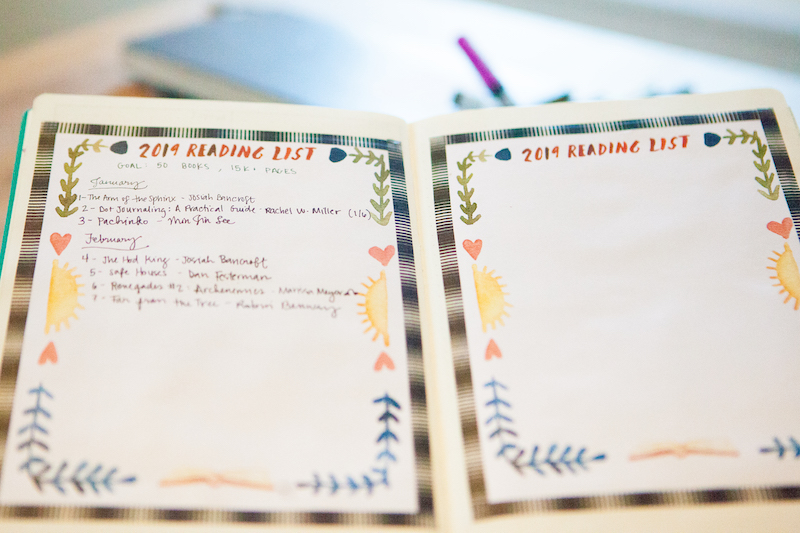
It’s okay to be aspirational. Listen. I’m sitting here telling you to be cool and not overdo it with your bullet journal, when I know full well this book sitting right next to me is slathered in washi tape and spreads designed by a professional artist and all kinds of pretentious shit. The old journals piled under it are filled with trackers I made with high hopes of developing life-changing habits… then abandoned. It’s all part of the process. A few years back, I hosted a lengthy bullet journal discussion thread on my Facebook page, in which several friends noted with envy my list of daily and weekly chores. I assured them that said chores were ambitions, not realities. I record lists like this so that I don’t waste time dithering around, wondering what to do and where to start, but so that I have something concrete to tackle when the opportunity arises. Indeed, a bullet journal can be as spare and minimal as you want – but if filling it with designs or itemizing your dreams in a spread brings you joy, go for it.
The takeaway here is that a bullet journal is not a magic, er, bullet. It will not effortlessly transform you into a totally organized, together person. Like most things, you get out of it what you put into it. If you’re looking for structure with a dash of free will, if you need a home for your fascinations and foibles and lists titled “Where Did I Hide That Thing From Myself,” bullet journaling is a good place to start. If nothing else, you can use it for show and tell at therapy.
-
Favorites January 2019

Heidi of 101cookbooks does these lists every once in awhile and I love them. Here’s what I’m loving.
This interview with Molly Rosen Guy (Shop Doen). My Dad used to tell his doctor that he just wanted to get well soon so he could go home and read the Chicago Tribune every morning in his favorite chair by the window.
My friend Erin told me about Kid Gorgeous, the hour long comedy special on Netflix and I’m so glad she did. His robot bit had me laughing hysterically (with headphones, after bedtime, with old halloween candy, as a parent might do). More laughter for January!
I’ve been making this light, tasty chicken stir-fry recipe for ten years and the sauce is still my favorite mix of soy-vinegar-garlic-ginger. If you can get Boston lettuce, the wraps are really fun, but tortillas will do, sour cream adds a lot as well. (Martha Stewart)
This interview with RadioLab producer Latif Nasser. “I love Google Alerts. I have dozens of them active at any given time.”
A passion project of Alice of Forest Bound, the Cabin Escapes Directory is so fun to page through, imagine getaways and nab interior decoration ideas.
Light, bendy, and rechargeable, these clip-on reading lights were a total win as Christmas gifts for the girls.
The pinterest account of Willaby, an organic blanket brand from Georgia.
-
February break, here
 We’re planning to stay in Boston for February break and I’m noting down the things to do with Lux at home and many other otherwise-weekly activities cancelled.
We’re planning to stay in Boston for February break and I’m noting down the things to do with Lux at home and many other otherwise-weekly activities cancelled.(I’ve also whiled away several hours looking at houses in Georgia O’Keeffe/Deborah Madison New Mexico. Coincidence?)
I foresee several luxuriously long library visits, at date night in, a hotel night out, a museum we would otherwise save for a weekend. A few of the things on my mind…
THE STAY SOMEWHERE ELSE AWAY
Downtown, the Lenox Hotel offers easy in-house activities for kids like Cookie & Paint night, movie night, or a crafting night. The Lenox is ideally located on the green line near the central Public Library, and a few stops from the MFA, both of which will also be offering special activities for the week. Interesting restaurants abound in this area, making it simple to stay indoors if the weather isn’t great. And do note they offer a few select rooms with working fireplaces! From $260 per night. The Lenox has offered us a free night stay in exchange for me sharing these facts, which we are totally taking advantage of.

On Cape Cod, the Bayside resort schedules full days of activities for the whole week, including themed (free) breakfasts, scavenger hunts, bingo, movie nights, pizza nights and simultaneously scheduled parent’s happy hours. Plus, you’ll have the winter beaches to yourself. One night from $159 per night.
THE AMAZING OUTDOORS
The Highland Foundations sponsors totally free skating at the Boston Common Frog Pond.
New Hampshire Ice Castles: These are built new every year in New Hampshire from scratch and appear to be rather amazing. We’ve never been, but I’d love to take an afternoon to get up there. You can see photos here, and coordinate your visit with a fire show!
The Somerville Winter Market: every weekend on Saturdays, indoors, full of amazing food vendors!
MUSEUMS, YOUR FRIEND
The newly reopened Discovery Museum in Acton (about 40 minutes west of the city). This delightfully hands-on, low tech, and interactive museum could you keep your family busy all day.
**Giveaway now closed. The Museum is offering free admission for kids under 12 on March 3rd & 4th.
The Museum of Fine Arts places special kid-interactive crafting activities in galleries all around the museum. Often there are concerts and special guests as well. All of these activities are free with admission. Check their schedule posted online beforehand.

THE GREAT INDOORS, at home
Buy art supplies: I like to think of the money that would have been spent on the random dining out that happens on trips redirected to other things, like buying a new art supplies. Here are a few we love, and are currently out of; combine any of these with a leftover cereal box and I promise amazing things will come of it! Do-a-dots (two year olds love), pastels (particularly fun on black construction paper), shurtape, gold leaf, twistable crayons. Gold leaf and pastels are both special supplies that require adults checking in every now and then. Always useful: this comprehensive list of the Eric Carle Museum Studio’s favorite kids art supplies.

^^ This is a recycled chocolate wrapper, not gold leaf, but we’ve done similar activities with that fluttery gold multipurpose dazzle!
Handwriting hobby After a recent conversation with the first grade teachers, I realized significantly less time is made for handwriting practice in today’s school curriculum. Much more time is spent on writing and writing comprehension. This empowers them as writers (or it has, for Lux) but the actual technique gets left behind. So we are working on this habit at home! Paired with a yummy snack and cozy rug, it’s a great activity and all you need are some ruled papers, or order your own handwriting book.
Count the dice Another activity I’m borrowing from Lux’s classroom hints. The kids make charts with a column for each number from 1-12. Then you get two dice, roll them, and color in the box above the number you received, pass the dice to the next person. It’s the simplest thing, but it seems to be satisfying in those ways that adults love too–rolling dice, reading numbers, checking off boxes. It’s communal and fun to do around the table.

Making your own play dough has gotten a rap as trademark ultra-homemade-crowd, but really, it takes ten minutes and you get to pick the colors and end up with warm play dough. It lasts forever compared to the store bought stuff. I don’t use add spices but I do use the recipes that include coconut oil.
Pillow jump This is from the Waldorf crowd, best for toddlers up to age 3, but fun for all if you’re not worried about the downstairs neighbors. Take a step stool, put it in the middle of the floor. Surround with a big pile of pillows. Climb up, jump off. Repeat.
My Holidays guide to Boston, some of these things still apply.
Anything special on your schedule for February?
-
our favorite headphones

I was thrilled to see the Wirecutter’s review of kids headphones. There is not enough said about the brands on the market that don’t offer volume-limiting. When marketing to kids, it should be an obvious inclusion. After 80 hours of research Wirecutter’s resulting choice, a pair that goes for $100 on Amazon, looks pretty great. But I’m skeptical of bluetooth with kids—it sounds like a nightmare trying to resolve the pairing anytime it goes wrong (and you know it would). But the comfort level looks amazing for a child over age seven.
That said, the pair they awarded second place to are the OnanOff Buddy Headphones, which we’ve had since last spring. Built-in-splitter. Yup. I know. Brilliant. Solves so many issues, no matter what weird scenario you’re in–only one of the airline seat tvs in your row is working, only one of the downloaded shows is actually interesting, one of your iPads died enroute. And they retail for $33. Recommend.
-
invite the kids!
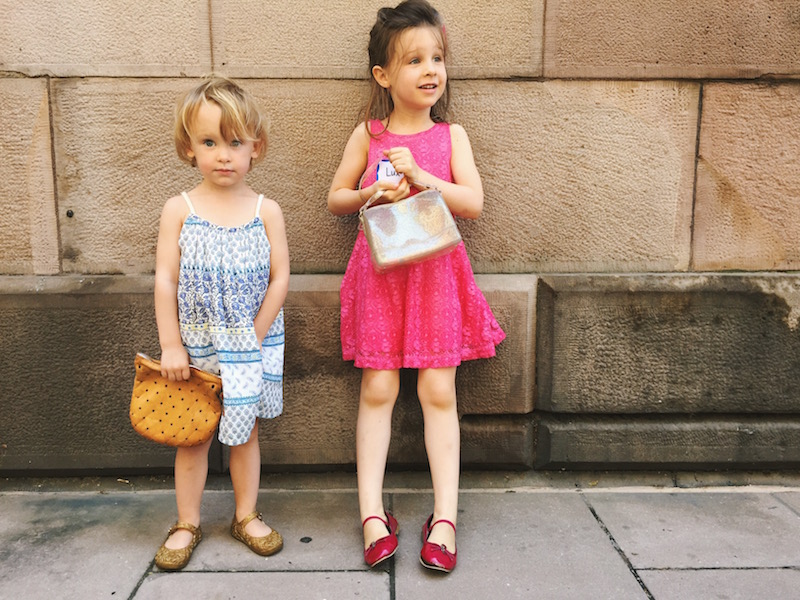
Last week I wanted to hear Lucy Keating speak at the athenaeum, a library and event spot up the street from me. Lucy wrote dreamology a fantastic and fun young adult novel set in Boston. I loved the writing and admire Lucy for writing such a lighthearted and inventive novel. The event was at noon, so I needed to make a plan for all the three of the girls to attend with me.
The situation reminded me of one my favorite kids-tag-along hacks that I learned from my friend Ashley. Ashley brings her daughter to ballets, plays, and events of all sorts. She buys special candy treats, and then, puts the candy into new bags. The plastic that candy is packaged in is quite possibly the noisiest thing on earth, times ten if you’re in a silent symphony hall. But if you decant the candy into new disguised bags, like the girls are holding above, not only will your children be able to eat silently, but also only a few people will even notice you are bribing them! Win win.
The talk was a real treat for me. And I loved the chance for Lux to see a young woman (Lucy is my age) author up front, talking about her writing process. Lux picked up phrases here and there and would look over at me and smile in recognition. Joan and Alma were rather oblivious but happy to not be at left at home anyway.
Do you have any favorite tips that makes it easier for kids to join adult events?
-
homedrawn calendars
Lux and I sit down and make these calendars fairly often. The lines are forever uneven and many times the last few days of the month have to be squeezed into one square due to lack of drafting. The symbols are rudimentary and would be meaningless if she hadn’t been sitting next to me as I drew, and explained them.
They allow for anticipation (the best part of any event!), and also preparation–like in the case of December having far more babysitters than any previous month.
They comprise what I refer to as my growing collection of mom outsider art. Outsider Art is a term I was introduced to by my art-major friends in college. They kindly said it described the charm of my half-life stick people and extremely rustic sketching abilities. As a term it’s not that popular to use any more (it can be seen as needlessly discriminatory–why not just call it art, though it was created in the backwoods of Mississippi?).
And it wouldn’t have applied to me anyway because though I have no skill, I could have been trained, or at least I lived within the potentials of being trained, social-economically, mentally, and geographically.
ANYWAY. These calendars are very helpful to us whenever something is too distant in the future to discuss usefully. Like when was Halloween approaching and I was going to die if I had to tell her one more time how far away it was. So I would simply remind her to consult her calendar and count the days herself. And my plan with “movie day,” was to eliminate all queries about movie watching throughout the week. Friday was decided and marked on the calendar. I made a four day one when we went away and my mom came. And a shorter one for a long weekend when I was out of town.
They content most, if not all, of the repetitive questions that come as a verbal assault on my daily kitchen calm. Lux just asked me to make a brand new one for January, a very apt thing to do in the new year.
-
World’s Best Mom Watch

photo from American Apparel. Not my long fingers, alas.
This tiny Casio edition, released by American Apparel, is the best mom watch ever. The six numbers across the top designate a timed alarm you can set with the push of a button. I use it daily to pleasantly resolve sharing fights with my girls. The timer goes off 3 or 5 minutes later and they trade whatever toy was in dispute. They believe in the power of the timer because it is loud enough that we can all hear it beep, thus I never forgot to tell them to trade.
I also use it for clutch phrases such as “We’re leaving in 5 minutes.”
It tells you the date and day of the week. It’s slim, lightweight, and the leather strap is pinch-free. It doesn’t have a light, which is a bummer with infants’ night waking. (Or is it?)
I used it obsessively after Joe bought it for my birthday last year, then I lost it on vacation. Then last month, my Aunt Anne bought me a new one, hooray!

